

 
 
 

 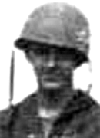
Click on the graphic to vote for this page as a Starting Point Hot Site. |
John Paul's Tribute To My Shipmates This page is dedicated to all my Shipmates, especially Bob Korczoski who devoted a lot of time, effort and money to reunite the Crew Members of L.C.T. 1269 after 50 years, when we participated in the Invasion of Iwo Jima. ***************February 19,1945**************** Frank T. Eddy (Skipper)---------------------Robert Korczoski Robert Betzold------------------------------Donald Kinney Glenn Skeen---------------------------------Joseph Lisak John L. Paul*-------------------------------Richard Vaughn Robert L. Pieffer---------------------------Carl Peterson Ramon Padilla-------------------------------George Gartleman Walter Horaney------------------------------James Farmer A.L.Baughman--------------------------------B.J. Macklin
Remember Iwo Jima********And********U.S.S.L.C.T. 1269 The tiny island of Iwo Jima is just under five miles long and two and a half miles wide at its widest point and has been described by many as a "pork chop" when viewed from the air. Located slightly south and west of the midpoint between Tokyo and Saipan, Iwo Jima is 625 miles north of Saipan and 660 miles south of Tokyo. The name of the island, Iwo Jima, translates to Sulfur Island for the numerous ground vents that spew sulfur fumes from underground sulfur springs. The island is mostly barren, with a 556-foot extinct volcano on the southern tip of the island (Mt. Suribachi), black sands, rocky cliffs, and no source of drinkable water. Situated between the Marianas Islands and Okinawa, the small island of Iwo Jima was another key link in the Allies' island-hopping strategy. Knowing this, the Japanese had fortified the island with a network of underground tunnels and bunkers. The battle for Iwo Jima was one of the bloodiest in U.S. Marine history, as the Japanese contested every foot of the island, often emerging from caves into territory thought secure. It was the largest armada invasion of the Pacific War. Although the famous flag-raising on Mt. Suribachi took place in mid-February, it was another month before the island was completely secured. The amphibious assault on Iwo Jima was considered to be the "ultimate storm landing," with a striking force of 74,0000 Marines. The US sent more Marines to Iwo than to any other battle, 110,000 Soldiers in 880 Ships. The convoy of 880 US Ships sailed from Hawaii to Iwo in 40 days. Although planners estimated the attack on Iwo should have been over within a week or less, they hadn't planned on the stubborn, savvy fighting of the estimated 21,000 Japanese troops on the island, who were experienced in island warfare after their many campaigns in the Pacific. Caves throughout the island were utilized by the Japanese military for a hospital, headquarters for the various Japanese officers on island, and even a sauna. Mt. Suribachi housed a seven-story interior structure used by the Japanese for stockpiling weapons, ammo, radios, fuel, and rations. The US Air Force pounded Iwo in the longest sustained aerial offensive of the war. "No other island received as much preliminary pounding as did Iwo Jima."(Admiral Nimitz, CINPAC) Incredibly, this ferocious bombardment had little affect. Hardly any of the Japanese underground fortresses were touched. |
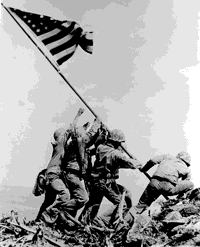

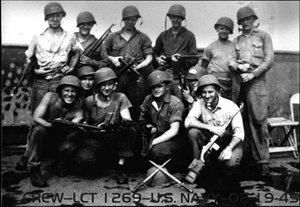
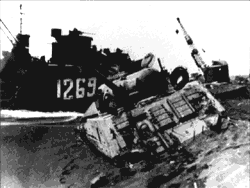
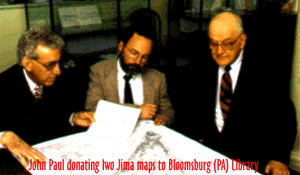
 View
the NAVetsUSA Ship's Log
View
the NAVetsUSA Ship's Log